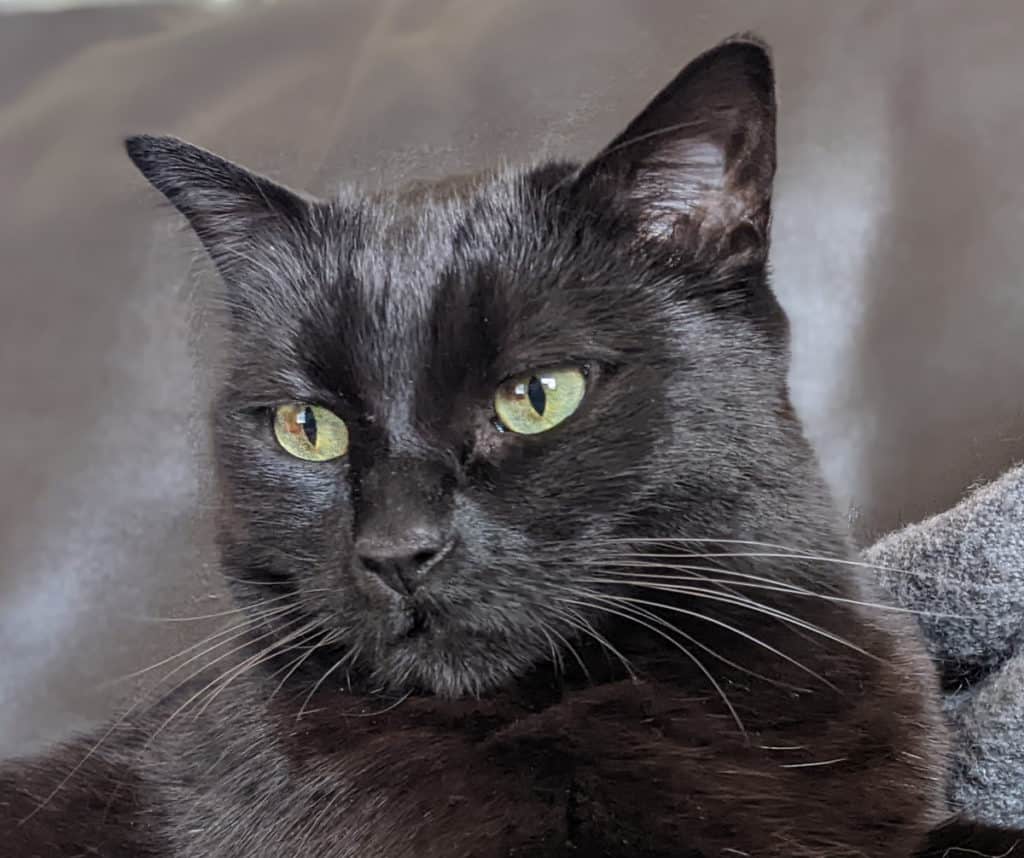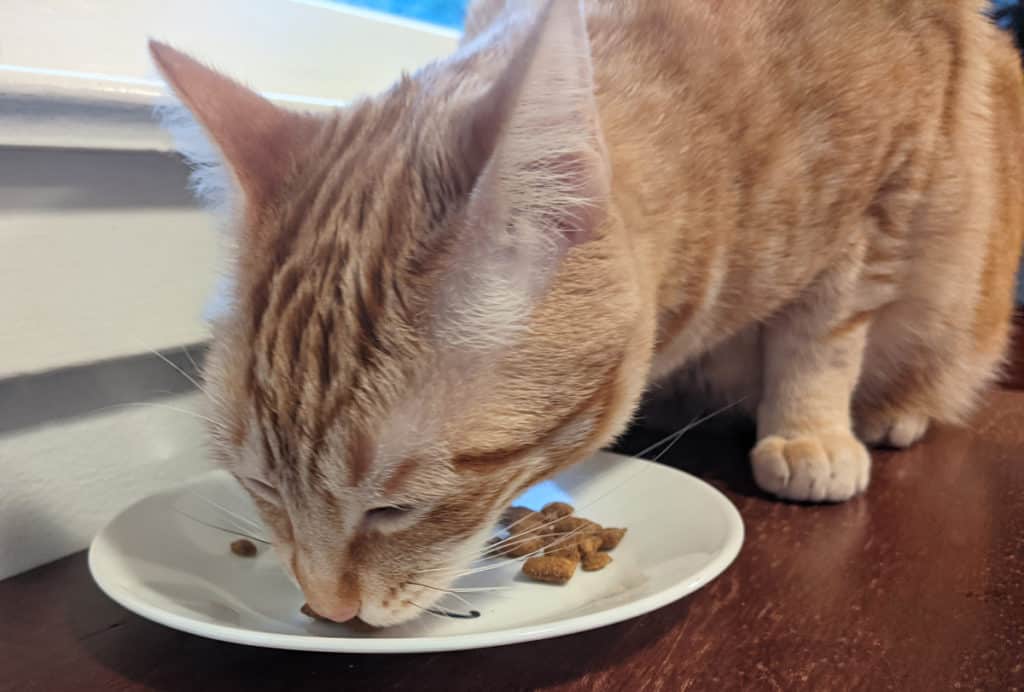A cat’s whiskers are positioned on the side of their head and they also have a few on their muzzle. Each whisker is attached to a follicle and a hollow part of the skin right under their fur.
The whiskers on a cat’s face are extremely sensitive and in the wild, they are the cat’s primary source of information. Whiskers play an important role in your cat’s life and health and therefore you need to be aware of what can cause whisker fatigue.
What are Cat Whiskers?
Whiskers are essentially a complex antenna that the cat uses to react to their environment. Whiskers are more commonly known as vibrissae, which are long, thick hairs that cats have on their face. These vibrissae are genetically programmed to give them whisker sensitivity by anchoring themselves in a bed of nerves on the cat’s face that allows the cat to navigate his or her world while staying protected.
As cats have evolved over time into a smaller domesticated counterpart of the wild cat species that still roam this planet today like lions and tigers, whiskers provide sensitive responses to their environment making their slightly shorter body sizes virtually undetectable if they’re hiding inside dark spaces and/or stalking prey before pouncing.

Cats Use Whiskers to Sense What’s Around Them
Cats can use their whiskers to help them see in the dark and determine where they’re going or whether they’ll fit into tight spaces. Cats are also able to sense various airflow patterns and flows, as well as being able to detect imperceptible changes in such delicate things as odor density.
Dr. Leonie Richards, a professor at the University of Melbourne, notes that “in addition to being a tool for detecting danger like petting by an unfamiliar human hand or some other predator, whiskers are extremely sensitive to the tiniest changes in air current, making them very important sensory input devices”.

Cats Show Their Feelings Through Their Whiskers
The position of a cat’s whiskers is an indicator of its feelings. When a cat is happy and relaxed, it has slightly droopy whiskers. Fearful or threatened cats have their whiskers “pinned back” against the face; this describes the appearance of fear on a cat’s features. If a cat looks angry, sometimes its whiskers may be held forward or stuck straight out rather than being relaxed or hanging downward.
What Can Cause Whisker Fatigue?
Cat whiskers may seem thin and fragile, but they can really take a lot of abuse. Under the right circumstances, however, they can become stressed when they’ve been overused. This is more common than one might think. An often-overlooked cause of whisker stress is related to feeding and watering.
The tiny whiskers on cats’ faces are designed to detect air currents, but cat food and water bowls are often too small for their facial whiskers. So when the kitty’s trying to chow down or get a drink, it’s common for his facial whiskers to be “trapped” between the side of the bowl and his face. This can cause irritation or even pain for some felines, usually at the base where the whisker meets the sensitive skin of your cat’s nose.
Cats with whisker pain or whisker stress often exhibit these signs of aggression: they can’t settle down, they eat only the middle of their food bowl, and often try to tip their food on the floor to eat it from there. Some cats are also more aggressive toward other pets when there’s a chance that the intruder may be interested in his food dish.
How Does Whisker Stress Affect Cats?
Unfortunately, whisker fatigue in cats is often related to something called ‘Mealtime Stress’. Most cat owners with experience in the ownership of a cat know what this means: it’s one thing to feed the kitty anything and everything, but when it comes to meal planning that gets more challenging than usual.
Some signs by which whisker stress affects cats are:
- Cats refuse to eat anything.
- They usually pace around the food bowl.
- Try to pull their food out of the food bowl on the floor.
- Always making a mess around their food and water bowl.
- Don’t like to eat if the food bowl is not full.
- Cat shows hunger even if the food is present in the bowl.
- Show aggression during mealtime.
Dental diseases, gastrointestinal problems, and behavioral issues are the other problem in which cats shows these symptoms. Seeing patterns in your cat’s habits is a big help when it comes to pinpointing the source of these problems so make sure you check out their symptoms and seek professional advice if you want to know more.
How to Help Prevent Whisker Fatigue In Cats

- When feeding your cat, make a little room in the center of their bowl to place the food. Alternatively, you can place the food on a flat surface like a dinner plate or saucer. This way will be easier for your cat to eat and not get anything stuck along their whiskers.
- Do not use water bowls for your cats, instead get a running water fountain for your cat. Cats prefer to drink from a flowing water source rather than drinking from a bowl with stale, tepid water. Running water also attracts your cat due to its instinctual ability of drinking water in the wild.
- If you have a pet cat, it’s important to keep them clean – especially their whiskers! While the image of a cat licking its whiskers might seem funny, doing so often can cause the sensitive hairs to become frayed and may even make your cat feel uncomfortable.
- You should never trim your cat’s whiskers. Although feline lovers believe it can prevent whisker fatigue, trimming the sensory organ can actually impair a pet’s ability to sense danger and will make him angry or confused.
Conclusion
A lot of cat owners have never heard of cat whisker fatigue and they may be surprised to learn that it does exist. If your cat has whisker fatigue, it is important to take care of it because it is a serious cat health problem. However, you can prevent this problem by following the simple tips mentioned above.
Read next: Where Do Cats Have Whiskers?
References
Hanlon, P. (2016, September 23). Why a cat’s whiskers are the bee’s knees. Pursuit – University of Melbourne. https://pursuit.unimelb.edu.au/articles/why-a-cat-s-whiskers-are-the-bee-s-knees
Slovak, J. E., & Foster, T. E. (2021). Evaluation of whisker stress in cats. Journal of Feline Medicine and Surgery, 23(4), 389-392. https://doi.org/10.1177/1098612X20930190






